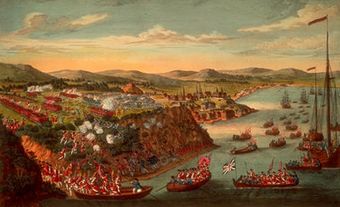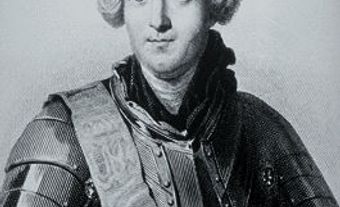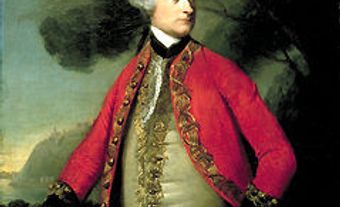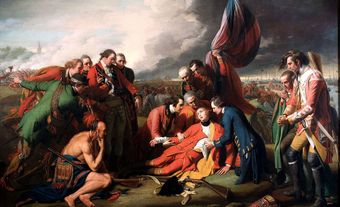On 28 April 1760, during the Seven Years’ War, the confrontation known as the battle of Sainte-Foy took place on the heights of Quebec City between the French and British armies. Seven thousand men under the command of French general François-Gaston de Lévis met 3,400 soldiers under the command of General James Murray in violent combat which ended with a major victory for the French. Following the battle, the French laid an unsuccessful siege to Quebec City and were eventually forced to retreat due to the arrival of British reinforcements on the St. Lawrence River.

A Precarious Situation
On 18 September 1759, the day after the capitulation of Quebec City, both the French and British armies found themselves in a precarious situation. The Battle of the Plains of Abraham (which had taken place several days earlier) had led to the death of the two enemy generals, Louis-Joseph de Montcalm and James Wolfe, leaving their respective staffs to assume command.
While the British had conquered the city, it had been partially destroyed by the intensive bombing it was subjected to during the summer. In addition, the British had looted the crops and livestock in the surrounding area during the siege of Quebec City, worsening the famine which was already ravaging the colony. Leaving only a few ships behind, the British fleet withdrew to Halifax. A garrison of 7,000 men remained in Quebec City under the command of Colonel James Murray, who became the British commander of the city. The winter was difficult for these men, whose numbers were decimated by scurvy, fever and dysentery. The number of able-bodied soldiers dropped to 4,000. Despite the losses, James Murray used his forces to improve the city’s defences with additional fortifications, including a series of small wooden forts called blockhouses.
For the French, the situation was difficult, but promising. Troop morale was low following the defeat in the battle of the Plains of Abraham and the army was disorganized. Yet, although weakened, the French army remained a force to be reckoned with. Following the death of General Louis-Joseph de Montcalm, the command of the troops fell to Chevalier François-Gaston de Lévis, a skilled, ambitious officer. As soon as he was promoted, he reassembled the routed army and had it march on the city. It was then that he learned of the city’s surrender. He had to resign himself to turning back and spent the winter in Montreal with his troops.
Did you know?
In the 18th century, military custom required mutual respect between opposing officers. These officers were most often members of the nobility and were highly educated. This was manifest in the way they conducted themselves, including on the battlefield.During the winter of 1760, James Murray and François-Gaston de Lévis maintained a polite correspondence, in particular regarding the exchange of prisoners. François-Gaston de Lévis even sent James Murray some remedies for scurvy, to which General Murray responded by sending him Cheshire cheese.
Battle of Sainte-Foy
On 20 April 1760, François-Gaston de Lévis gathered his army and marched on Quebec City. He had approximately 7,000 men, half of whom were regular soldiers, while the remainder were militiamen and Indigenous allies. His intent was to take the city quickly, before the spring thaw, in order to surprise the British garrison. James Murray got wind of the French advance and recalled his advance detachments from Lorette and Sainte-Foy to concentrate his forces in Quebec City. Despite this, he was only able to deploy 3,400 men against the French. However, he also had a powerful 22-gun artillery, which he positioned on the Buttes-à-Neveu bluffs, the highest point in the area. The battle took place slightly to the west of where the Battle of the Plains of Abraham was fought. This time, however, the situation was reversed, with the British defending Quebec City.
On 28 April 1760, the first columns of the French army emerged onto the battlefield from the woods of Sillery. The British army was waiting for them. James Murray was impatient and wanted to attack before the French could deploy. Hoping to thwart his adversary, he ordered an immediate attack. However, by placing his men in the line of fire of his cannons, he could no longer use his artillery and thus lost a major tactical advantage.
This strategy was somewhat successful, however, as it caught François-Charles de Bourlamaque (the officer commanding the vanguard of the French army) off guard. He was unable to deploy his troops correctly and suffered heavy losses. However, once the initial confusion had subsided, the situation improved. The Troupes de la Marine and the Canadian militia (who were very familiar with the local trails) arrived to reinforce them and threw themselves into the fray, charging the enemy with bayonets. This terrible shock broke the British momentum. The two armies gradually regrouped, meeting in the Montcalm neighbourhood of Quebec City, at approximately the site of today’s Avenue des Braves (a street whose name commemorates those who sacrificed their lives in this confrontation).
During the pitched battles of the 18th century, the adversaries deployed their troops in lines two- or three-men deep and exchanged fire until one side or the other led a bayonet charge. North of the battlefield, near the Dumont mill on Chemin Sainte-Foy, the fighting was especially fierce. At 10 metres in height and with its thick walls, the mill was a coveted strategic location. The French grenadiers rushed to take it at the outset of the battle but were quickly forced out by the British Light Infantry. The troops from the Béarn Regiment then stormed the mill again, only to be driven back by the grenadiers of the 35th Regiment of Foot.
While his men kept the British occupied on his left flank, General François-Gaston de Lévis went on the attack on his right and began an encircling maneuver. The attack by the French army was so intense that the British front began to buckle under the pressure. After three hours of fierce fighting, James Murray finally had to give up and sound the retreat. The British took shelter inside the city walls. The French were victorious, but the cost of the victory was high.
Toll and Consequences of the Battle
The toll of the Battle of Sainte-Foy was higher than that of the Battle of the Plains of Abraham. On the French side, 193 soldiers were killed and 640 wounded. On the British, 229 were killed, 857 wounded and 53 were taken prisoner. The victory gave the French hope that they might retake Quebec City, but they had to do it quickly as both armies were awaiting reinforcements from Europe.
François-Gaston de Lévis ordered a siege of the city. Trenches were dug and cannon batteries were aimed at the ramparts. Lévis was very familiar with the weaknesses of the fortifications and concentrated his fire on the Glacière bastion, the site of a pillbox. However, his cannons were not powerful enough to breach the walls. Worse, due to a lack of powder, he could only fire his cannons 20 times a day. From the ramparts, the British bombarded the French positions and inflicted substantial damage. Finally, the arrival of British ships completely extinguished the hopes of François-Gaston de Lévis. He raised the siege and ordered a retreat towards Montreal.

The battle of Sainte-Foy was the final confrontation between the French and the British in the St. Lawrence Valley during the Seven Years’ War. Significantly weakened and no longer able to rely on support from the city, the number of French fighters was reduced to 2,100. The army quickly found itself surrounded by three British armies numbering 18,000 men who were converging on Montreal, which capitulated on 8 September 1760. (See Capitulation of Montreal, 1760.)

 Share on Facebook
Share on Facebook Share on X
Share on X Share by Email
Share by Email Share on Google Classroom
Share on Google Classroom



